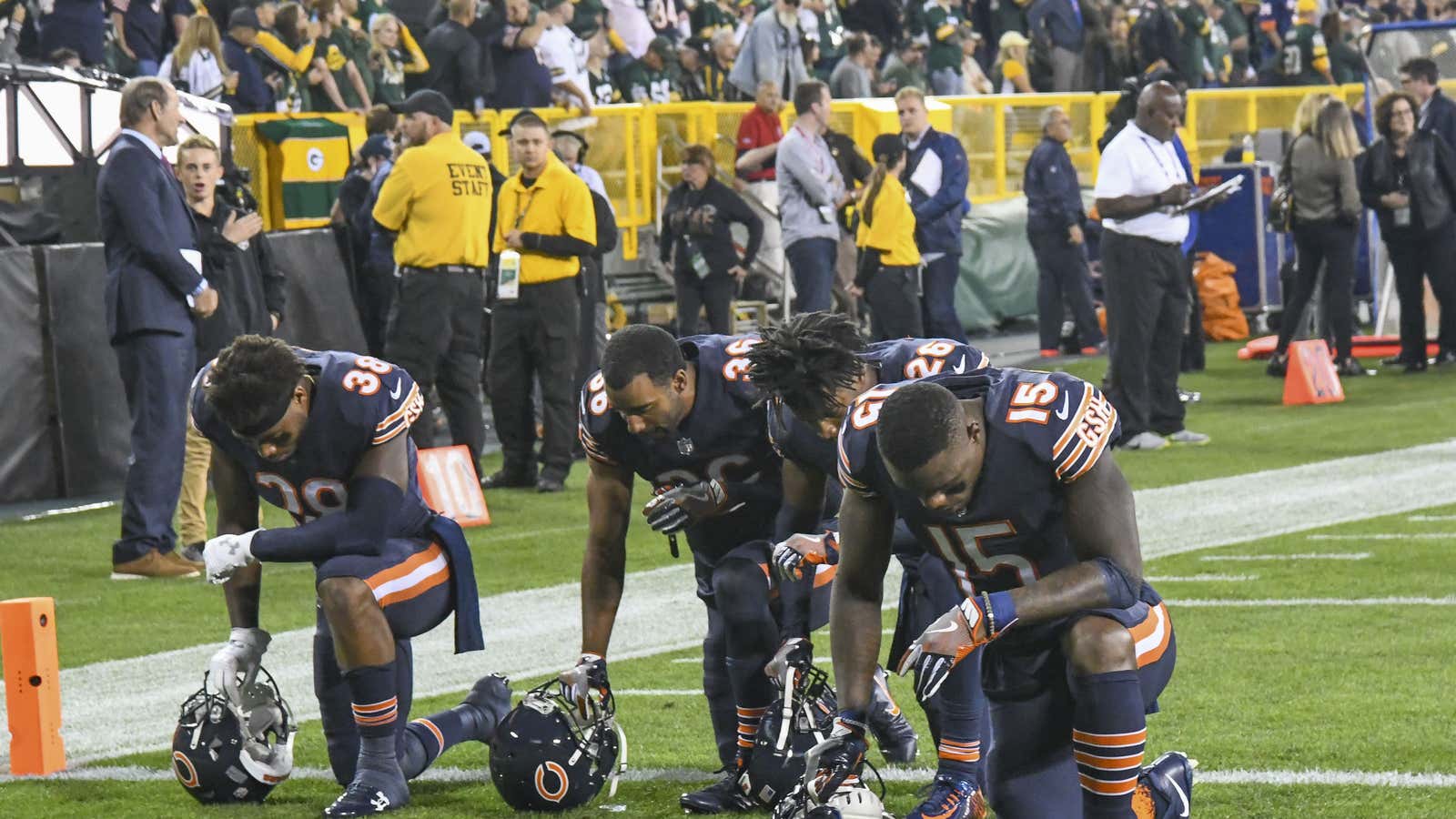In 1940, the United States Supreme Court issued a ruling that, if it held today, would likely have made the current NFL “Take a Knee” protests illegal.
The case concerned a brother and sister who were Jehovah’s Witnesses. They had been expelled from school for refusing to say the pledge of allegiance or salute the US flag in class, a standard practice at the time. The court agreed with the school’s decision. “National unity is the basis of national security,” the judges said. “We live by symbols.”
But just three years later, almost all the court’s judges realized they’d made a huge mistake. The original ruling had prompted a wave of hate the likes of which America hadn’t seen for decades and clearly contravened the freedoms guaranteed by the constitution. In a second case involving expelled Jehovah’s Witnesses, they reversed their earlier decision, and confirmed the freedom of Americans to protest a flag or refuse to take the pledge if doing so went against their conscience. The basic message: freedom of speech trumps patriotism, even in wartime.
At a moment when the NFL is considering making its players stand for the anthem before games—and under immense pressure to do so from president Donald Trump and patriotic fans—perhaps it’s time to take a look back at that history and realize that protesting a flag or anthem is never a simple matter of patriotism. Being able to protest is actually a long-established right, and it’s a right that was established in the most American of circumstances: by a religious group, before the Supreme Court.
The Jehovah’s Witnesses first began refusing to salute national flags after the Nazis came to power in Germany in the 1930s and started demanding everyone do it. Many Witnesses refused, seeing doing so as idolatry—putting a country above God—and were beaten up for their trouble. News of the violence soon spread to America, where Witnesses also started questioning the respect they were required to show their national symbols.
In October 1935, two children from Minersville, Pennsylvania, Lillian and Billy Gobitis, agonized for weeks over whether they should say the pledge and salute the flag at their school. They mimed along for a few days, but then one afternoon Billy rushed home excited. “I stopped saluting the flag!” he told his parents, according to a fascinating account in Judging Jehovah’s Witnesses: Religious Persecution and the Dawn of the Rights Revolution. “The teacher tried to put up my arm, but I held onto my pocket.” The next day, Lillian stayed seated during the pledge. Both were soon expelled.
Their parents turned to the courts for help, but the 1940 Supreme Court ruling stopped them in their tracks. It also led to mob violence across America with Witnesses beaten, tarred and feathered, even kidnapped. Some were hanged, others forced to drink castor oil. Their businesses were boycotted and their homes set on fire. “Nothing parallel to this…has taken place since the days of the Ku Klux Klan in the 1920s,” the American Civil Liberties Union said at the time. The violence only calmed down after the Supreme Court reversed its decision.
The parallels between then and now are striking, “not just in the protests themselves, but the public response to them,” says Shawn Francis Peters, author of Judging Jehovah’s Witnesses. “In the 30s and 40s, the response was violent. We haven’t got to that point yet with the anthem protests, but you can see the same anger, and you can see people are still unwilling to scratch beneath the surface to learn just why individuals are protesting,” Peters says.
“For me that’s the most direct parallel—and it’s the saddest parallel too.”
At first glance, the Witnesses’ experience is a positive lesson for today’s protestors. After all, the Supreme Court eventually ruled in their favor. But a deeper look shows that interpretation is wrong. For 80 years, the Witnesses have faced criticism for refusing to sing anthems or salute flags everywhere from Rwanda to Singapore. Earlier this year, the group reportedly considered legal action against a requirement that India’s anthem be played in cinemas.
In 1988, The New York Times tracked down Billy Gobitis during another row over the pledge, when then-president George H.W. Bush was pushing for a bill that would have fined teachers who didn’t force children to say it every day. Gobitis was not impressed with the issue reappearing. “It’s hard to comprehend why they’re raising this…again,” he said. “They’re ignoring our constitutional development and history.”
The fact the issue has still not gone away for the Jehovah’s Witnesses doesn’t bode well for today’s protesters getting their message across.
“I don’t think the Witnesses ever really got to the point that people truly appreciated or respected them,” Peters says. “I think people tolerated them, and circumstances changed—the hysteria of World War II abated. It’s possible that our collective rage over the anthem protests might similarly expend itself, but I don’t think people will ever be persuaded about why the protests are happening.”
The Witnesses aren’t the poster organization for civil rights by any means—they’ve faced criticism for reportedly suppressing scandals and bullying former members. When contacted for this article, a spokesperson said: “We don’t get involved in issues unless they’re about impinging our religious freedom of thought.”
Despite this, Peters says people should remember what the Witnesses achieved. Particularly, they should keep in mind one line in the Supreme Court’s final ruling. “‘Compulsory unification of opinion achieves only the unanimity of the graveyard’,” Peters says. “That’s the takeaway.”
